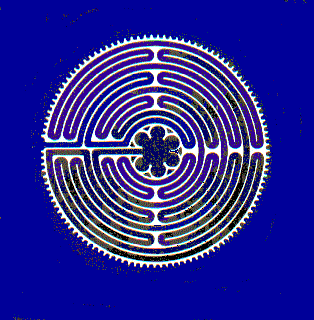What is a Labyrinth?
The Labyrinth is an archetype, a divine imprint found in religious traditions in various forms around the world. By walking the labyrinth, we are discovering a long-forgotten mystical tradition. The mysterious winding path that takes us to the center becomes a metaphor for our own spiritual journey. Going in, we release the cares and concerns, which distract us from our Source. The center is a place of prayer and meditation where we receive clarity about our lives. As we walk back on the same path that brought us in, we are granted the power to act. The walk is a shared journey, an activity which communities can do together to coalesce and unify vision. The labyrinth is a mandala that meets our longing for a change of heart; for a change of ways in how we live together on this fragile island home; and for the energy, vision, and the courage to become agents of transformation in an age when no less will suffice to meet the challenges of survival.
"We are not human beings on a spiritual path, but spiritual beings on a human path."
"In the labyrinth, the set path takes you to the center; that you know you will get to the center helps focus and quiet the mind."
"The labyrinth, is a place where you can pour your heart out, express your anger, experience joy, express gratitude, and perhaps above all, ask for what you need."
"We shall not cease from exploration and at the end of all our exploring will be to arrive where we startedAnd know the place for the first time"- T.S. Eliot
http://www.williams.edu/chaplain/whatisalabyrinth.php
History of the Labyrinth . . .
"The origin of the first labyrinth is unclear however it is known that this unique pattern dates back thousands of years and has been associated with many religious traditions. Throughout the ages the labyrinth has been represented in many forms and associated with different religious practices. The labyrinth has been found on coins, vessels, walls and the floors of religious buildings for thousands of years, most often in a religious or sacred context. Much of the original significance of the labyrinth has been lost in time, though this enduring symbol has survived to the present day. Labyrinths have been rediscovered in an age where pilgrimage is seen as a way of drawing nearer to God through self-knowledge and meditation which are believed to be vital aids to peace of mind, healing and reconciliation with God.
The most celebrated labyrinth is to be found on the floor of Chartres Cathedral in France where it is believed to have been used as a meditation aid by those making a symbolic journey. It is believed to date back to medieval times and is surrounded by many legends of its powers and significance. Being a complex pattern it is not surprising that many have found geometrical and mathematical significance in its design.
Today we regard the labyrinth as having no special or supernatural power of its own. It does, however, provide a unique and engaging framework for personal meditation. It may also be regarded as a piece of human art that draws us closer to God just as religious icons are regarded as divine or sacred works of human hands."
http://www.labyrinthmeditation.com/History.htm#top
Find more information on Labyrinths at







